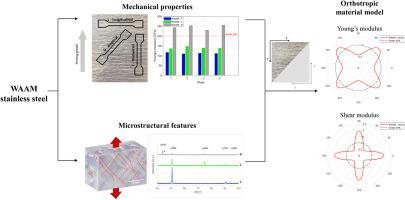Additive Manufacturing ( IF 11.0 ) Pub Date : 2021-04-09 , DOI: 10.1016/j.addma.2021.101999 Vittoria Laghi , Lavinia Tonelli , Michele Palermo , Matteo Bruggi , Ramona Sola , Lorella Ceschini , Tomaso Trombetti

|
Wire-and-Arc Additively Manufactured (WAAM) alloys are characterized by specific mechanical properties which can largely differ from the conventionally-manufactured alloys. In detail, the printing process results in a peculiar microstructure, characterized by preferential crystallographic orientation with reference to the printing direction, that leads to an anisotropic mechanical behavior of the printed part. Previous experimental tests on WAAM-produced stainless steel plates showed in particular a strong anisotropic elastic behavior. Based on the above, the present work formulates a specific anisotropic elastic model for a WAAM-processed austenitic stainless steel, considering an orthogonally anisotropic (or orthotropic) constitutive law and a procedure to calibrate the elastic parameters based on the experimental results. In detail, the procedure is applied to calibrate the numerical values of the elastic parameters of a specific WAAM 304L austenitic stainless steel. For this aim, specific investigations on both the mechanical and microstructural features were carried out. Experimental tensile tests were performed on specimens with different orientations with reference to the printing direction. In detail, Young’s modulus and Poisson’s ratios were evaluated for samples oriented along three different orientations with regard to the printing deposition layers: longitudinally (L), transversally (T) and diagonally (D) to them. Digital Image Correlation (DIC) optical measuring system was used to acquire the full strain fields during the test. Microstructural analysis was also carried out to study the inherent microstructure, characterized by a distinctive grain growth direction, and to assess the preferred crystallographic orientations of specimens extracted along the three considered directions. The experimental results are used to calibrate the orthotropic elastic model. From the calibrated model additional material properties in terms of Young’s and shear modulus for any printing direction are derived. The resulting values exhibit very large variations with the printing angle, with ratios between minimum to maximum values around 2 for the Young’s modulus and 3.5 for the shear modulus. This marked orthotropic behavior could open unexplored design possibilities based on deformability issues. Additionally, the calibrated orthotropic model can also be used for future experimental explorations of the mechanical properties of WAAM alloys and for stiffness-based structural design optimizations.
中文翻译:

经实验验证的线和圆弧增材制造不锈钢的正交各向异性弹性模型
线电弧附加制造(WAAM)合金的特点是特定的机械性能,与常规制造的合金有很大不同。详细地,印刷过程导致特殊的微观结构,其特征在于相对于印刷方向的优先晶体学取向,这导致了印刷部件的各向异性机械性能。以前在WAAM生产的不锈钢板上进行的实验测试特别显示出很强的各向异性弹性。基于上述内容,本工作考虑了正交各向异性(或正交各向异性)本构律以及根据实验结果校准弹性参数的过程,为WAAM处理的奥氏体不锈钢制定了特定的各向异性弹性模型。详细,该程序适用于校准特定WAAM 304L奥氏体不锈钢的弹性参数的数值。为了这个目的,对机械和微观结构特征进行了专门的研究。相对于印刷方向,在具有不同取向的样品上进行了实验性拉伸试验。详细地,对于相对于印刷沉积层沿三个不同方向取向的样品,评估了它们的杨氏模量和泊松比:相对于它们的纵向(L),横向(T)和对角线(D)。在测试过程中,使用了数字图像相关(DIC)光学测量系统来获取完整的应变场。还进行了微观结构分析,以研究固有的微观结构,其特征在于独特的晶粒生长方向,并评估沿三个考虑方向提取的标本的首选晶体学取向。实验结果用于校准正交异性弹性模型。从校准的模型中,得出针对任何印刷方向的关于杨氏和剪切模量的其他材料特性。所得值显示出随印刷角度的很大变化,杨氏模量的最小值与最大值之间的比率约为2,剪切模量的比率约为3.5。这种明显的正交各向异性行为可能会基于可变形性问题开辟未曾探索过的设计可能性。此外,校准的正交各向异性模型还可以用于WAAM合金的力学性能的未来实验探索以及基于刚度的结构设计优化。


























 京公网安备 11010802027423号
京公网安备 11010802027423号